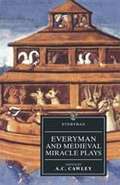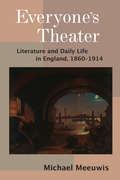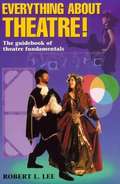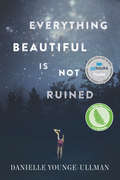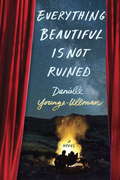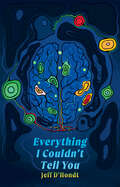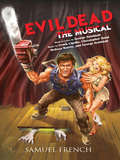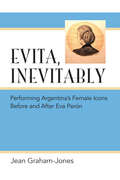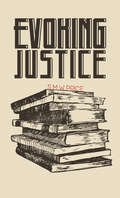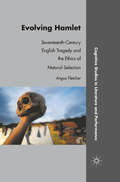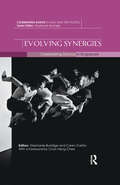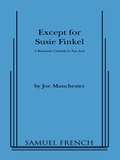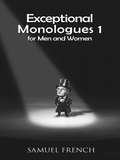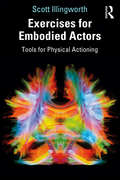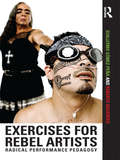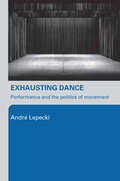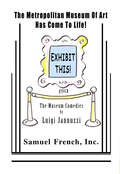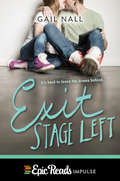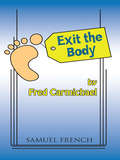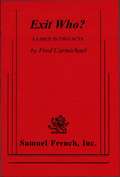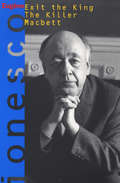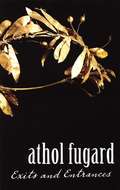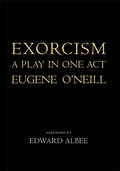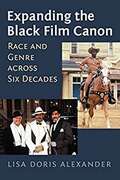- Table View
- List View
Everyman and Medieval Miracle Plays
by A. C. CawleyThis volume contains the moral play Everyman and a representative collection of medieval biblical pageants. The pageants have been chosen for their intrinsic merit and because together they give a fair idea of the range and content of an English Corpus Christi cycle. They are taken from the cycles of York, Chester, Wakefield, Coventry, and 'N. town', with the addition of an excerpt from the Cornish plays (Appendix I). Most of the original words of the plays are preserved, but for the convenience of the general reader many archaic forms and spellings are modernized or normalized both within the line and in rhyme. Occasionally, however, an archaic form is kept for the sake of the rhyme, and a gloss added if necessary. Original stage directions are given and those in Latin are translated; they are distinguished from editorial directions, which are bracketed. Difficult words and short phrases are glossed in the margin, while longer word-groups needing explanation are paraphrased in footnotes.
Everyone’s Theater: Literature and Daily Life in England, 1860–1914
by Michael MeeuwisNearly all residents of England and its colonies between 1860 and 1914 were active theatergoers, and many participated in the amateur theatricals that defined late Victorian life. The Victorian theater was not an abstract figuration of the world as a stage, but a media system enmeshed in mass lived experience that fulfilled in actuality the concept of a theatergoing nation. Everyone’s Theater turns to local history, the words of everyday Victorians found in their diaries and production records, to recover this lost chapter of theater history in which amateur drama domesticates the stage. Professional actors and playwrights struggled to make their productions compatible with ideas and techniques that could be safely reproduced in the home—and in amateur performances from Canada to India. This became the first true English national theater: a society whose myriad classes found common ground in theatrical display. Everyone’s Theater provides new ways to extend Victorian literature into the dimension of voice, sound, and embodiment, and to appreciate the pleasures of Victorian theatricality.
Everything About Theatre!: The Guidebook Of Theatre Fundamentals
by Robert L. Lee Theodore O. ZapelAn overview of all aspects of theatre The history, the crafts and the art of the stage are presented in eighteen units.
Everything Beautiful Is Not Ruined
by Danielle Younge-UllmanThen Ingrid traveled all over Europe with her opera star mother, Margot-Sophia. Life was beautiful and bright, and every day soared with music. Now Ingrid is on a summertime wilderness survival trek for at-risk teens: addicts, runaways, and her. She’s fighting to survive crushing humiliations, physical challenges that push her to her limits, and mind games that threaten to break her. Then When the curtain fell on Margot-Sophia’s singing career, they buried the past and settled into a small, painfully normal life. But Ingrid longed to let the music soar again. She wanted it so much that, for a while, nothing else mattered. Now Ingrid is never going to make it through this summer if she can’t figure out why she’s here, what happened to Margot-Sophia, and why the music really stopped.From the Hardcover edition.
Everything Beautiful Is Not Ruined
by Danielle Younge-UllmanIn the tradition of Sara Zarr and A. S. King, a girl must survive an extreme wilderness experience to prove to her mother that she has the strength to pursue her dreams.Then: Ingrid traveled all over Europe with her opera star mother, Margot-Sophia. Life was beautiful and bright, and every day soared with music.Now: Ingrid is on a summertime wilderness survival trek for at-risk teens—addicts, runaways, and her. She’s fighting to survive crushing humiliations, physical challenges that push her to her limits, and mind games that threaten to break her.Then: When the curtain fell on Margot-Sophia’s singing career, they buried the past and settled into a small, painfully normal life. But Ingrid longed to let the music soar again. She wanted it so much that, for a while, nothing else mattered.Now: Ingrid is never going to make it through this summer if she can’t figure out why she’s here, what happened to Margot-Sophia, and why the music really stopped.
Everything I Couldn't Tell You
by Jeff D'HondtRevived from a coma after a traumatic event, Megan’s injuries leave her capable of great violence, forcing her desperate physician Cassandra to recruit Alison, an Indigenous clinician, as her consultant. Alison uses an innovative form of technologically enhanced expressive arts therapy to augment the rehabilitative effects of speaking Lenape, their shared (and almost extinct) language. However, this reminder of cultural expression and identity triggers Megan, putting herself into a life-threatening situation. With Megan’s safety in jeopardy, Alison must internalize a life-changing lesson to save her: pain is often unjust, but it also reminds us that we’re alive.Everything I Couldn’t Tell You is a potent reminder of the healing and rehabilitative power within Indigenous languages.
Evil Dead: The Musical
by George Reinblatt Frank Cipolla Christopher BondMusical Comedy / 6m, 4f / Unit set / Based on Sam Raimi's 80s cult classic films, EVIL DEAD tells the tale of 5 college kids who travel to a cabin in the woods and accidentally unleash an evil force. And although it may sound like a horror, it's not! The songs are hilariously campy and the show is bursting with more farce than a Monty Python skit. EVIL DEAD: THE MUSICAL unearths the old familiar story: boy and friends take a weekend getaway at abandoned cabin, boy expects to get lucky, boy unleashes ancient evil spirit, friends turn into Candarian Demons, boy fights until dawn to survive. As musical mayhem descends upon this sleepover in the woods, "camp" takes on a whole new meaning with uproarious numbers like "All the Men in my Life Keep Getting Killed by Candarian Demons," "Look Who's Evil Now" and "Do the Necronomicon." / Outer Critics Circle nomination for Outstanding New Off-Broadway Musical
Evita, Inevitably: Performing Argentina's Female Icons Before and After Eva Perón
by Jean Graham-JonesEvita, Inevitably sheds new light on the history and culture of Argentina by examining the performances and reception of the country's most iconic female figures, in particular, Eva Perón, who rose from poverty to become a powerful international figure. The book links the Evita legend to a broader pattern of female iconicity from the mid-nineteenth century onward, reading Evita against the performances of other female icons: Camila O'Gorman, executed by firing squad over her affair with a Jesuit priest; Difunta Correa, a devotional figure who has achieved near-sainthood; cumbia-pop performer Gilda; the country's patron saint, the Virgin of Luján; and finally, Argentina's president, Cristina Fernández de Kirchner. Employing the tools of discursive, visual, and performance analysis, Jean Graham-Jones studies theatrical performance, literature, film, folklore, Catholic iconography, and Internet culture to document the ways in which these "femicons" have been staged.
Evoking Justice
by S M W PriceWhat would you do if you were given access to a window into the past? Staring out of the window, the social nuances wouldn't be obvious. Without context, the view might show abject squalor, poverty and ignorance but not enough to understand how people responded to such detrimental societal influences. Criminals would have been dealt with relative to the times, reflective of civic tolerances and in stark contrast to our contemporary collective consciences; which have evolved for a reason. Would you really want to go back and evoke justice from the past? One woman did just that and with the help of a friend, managed to turn back time. She didn't stop to consider in her mission, that just because she had the determination to achieve her goal didn't necessarily mean she should. She put her faith in fate, and fate gave her much more of an insight than anticipated…
Evolving Hamlet
by Angus FletcherUsing Hamlet and a number of other popular and influential seventeenth-century tragedies as case-studies, this book shows how aesthetic experience can help organize the biological functions of our brains into adaptive social networks.
Evolving Synergies: Celebrating Dance in Singapore (Celebrating Dance in Asia and the Pacific)
by Stephanie Burridge Caren CariñoA comprehensive overview of the dance culture of Singapore, this book embodies storytelling, personal reflections, memories, and histories of the artists. The extensive calendar of events encompassing companies and soloists from diverse dance practices, such as Indian, Malay and Chinese and a variety of Western contemporary dances, underline Singapore as a vibrant player in the evolution of Asian culture.
Except For Susie Finkel
by Joe ManchesterFull Length, Romantic comedy / 3 m., 2 f. / Interior / Jonas Fox is enjoying a swinging bachelor life when his father arranges a marriage with Shoshana Gluber, a shy, awkward, introverted and plain stranger from the Bronx. Angered by the threatened disruption of his idyllic life, Jonas refuses to marry the girl of his father's dreams that is until he realizes there may not be an alternative. What follows is a delightful laugh filled evening. / "This play believes in love, both spiritual and physical. . . . Sends one from the theater with a smile." Cleveland Plain Dealer .
Exceptional Monologues for Men & Women Volume 1
by Roxane Heinze-BradshawIn an effort to foster awareness of new plays, and provide for the ever-constant need of audition material, we are proud to announce a new series of monologue books highlighting the latest Samuel French publications. Each year, starting with 2008, monologues from or most recent publications will be selected by our editorial staff to be included in that year's collection. Complete with play synopses, a thematic index, and broad range of styles, you are sure to find one that suits your audition needs. A wonderful way to sample our latest publications, too! Volume 1 includes such titles and authors as: Eurydice by Sarah Ruhl, The Receptionist by Adam Bock, In the Continuum by Danai Gurira & Nikkole Salter, Bach at Leipzig by Itamar Moses, and many more.
Exercises for Embodied Actors: Tools for Physical Actioning
by Scott IllingworthExercises for Embodied Actors: Tools for Physical Actioning builds on the vocabulary of simple action verbs to generate an entire set of practical tools from first read to performance that harnesses modern knowledge about the integration of the mind and the rest of the body. Including over 50 innovative exercises, the book leads actors through a rigorous examination of their own habits, links those discoveries to creating characters, and offers dozens of exercises to explore in classrooms and with ensembles. The result is a modern toolkit that empowers actors to start from their own unique selves and delivers specific techniques to apply on stage and in front of the camera. This step-by-step guide can be used by actors working individually or by teachers crafting the arc of a course, ensuring that students explore in physically engaged and dynamic ways at every step of their process.
Exercises for Rebel Artists: Radical Performance Pedagogy
by Guillermo Gómez Peña Roberto SifuentesIn Exercises for Rebel Artists, Guillermo Gomez-Pena and Roberto Sifuentes use their extensive teaching and performance experience with La Pocha Nostra to help students and practitioners to create ‘border art’. Designed to take readers right into the heart of radical performance, the authors use a series of crucial practical exercises, honed in workshops worldwide, to help create challenging theatre which transcends the boundaries of nation, gender, and racial identity. The book features: Detailed exercises for using Pocha Nostra methods in workshops Inspirational approaches for anyone creating, producing or teaching radical performance A step-by-step guide for large-scale group performance New, unpublished photos of the Pocha Nostra method in practice Exercises for Rebel Artists advocates teaching as an important form of activism and as an extension of the performance aesthetic. It is an essential text for anyone who wants to learn how use performance to both challenge and change.
Exhausting Dance: Performance and the Politics of Movement
by Andre LepeckiThe only scholarly book in English dedicated to recent European contemporary dance, Exhausting Dance: Performance and the Politics of Movement examines the work of key contemporary choreographers who have transformed the dance scene since the early 1990s in Europe and the US. Through their vivid and explicit dialogue with performance art, visual arts and critical theory from the past thirty years, this new generation of choreographers challenge our understanding of dance by exhausting the concept of movement. Their work demands to be read as performed extensions of the radical politics implied in performance art, in post-structuralist and critical theory, in post-colonial theory, and in critical race studies. In this far-ranging and exceptional study, Andre Lepecki brilliantly analyzes the work of the choreographers: * Jerome Bel (France)* Juan Dominguez (Spain)* Trisha Brown (US)* La Ribot (Spain)* Xavier Le Roy (France-Germany)* Vera Mantero (Portugal) and visual and performance artists: * Bruce Nauman (US) * William Pope.L (US). This book offers a significant and radical revision of the way we think about dance, arguing for the necessity of a renewed engagement between dance studies and experimental artistic and philosophical practices.
Exhibit 'A': Short Plays And Monologues
by Neil LaButeNeil LaBute has earned international acclaim for his provocative body of work for the stage. His bold vision is amply evident in this new collection of daring and stylishly realized short plays and monologues. In the title play, Exhibit ‘A’, an artist pushes the boundaries of his art to a previously untouched frontier, challenging the very definition of “art.” 10K explores the territory where fantasy and desire merge, as a man and woman share secrets while traversing a suburban jogging path. Here We Go Round the Mulberry Bush is a tense confrontation between two men in a park. In Happy Hour, a guy and a gal meet cute in a bar. I’m Going To Stop Pretending (That I Didn’t Break Your Heart) lays bare a couple at the bitter end of a relationship, where devastation and loss for one is freedom and inevitability for the other. 16 Pounds is a bleak, near-future look at water scarcity; BFF is the stage adaptation of LaBute’s short film about three “friends”; Black Girls takes a white guy and a black girl through a wildly uncomfortable conversation; Some White Chick and The Unimaginable are two chillers written for Southwark Playhouse’s TERROR! Festival; and the monologue Totally is a young woman’s sex revenge confession like no other.
Exhibit This! The Museum Comedies
by Luigi JannuzziAll Groups / Comedy / 3f, 2m or 36 m or f, or an all female cast / Unit Set The Metropolitan Museum of Art has come to life! A fast-paced series of comedic plays and monologues based on 50+ exhibits at The Metropolitan Museum Of Art in NYC. Paintings, sculptures, antiquities, & fertility gods emerge from their molds & frames. Mix in some artists, guards, critics, lovers, curators and one very special night and you have this new comedic hit. In fact, even the artwork speaks to the audience! Using a variety of theatrical styles and rhythms, on a single set, it can be done with 3 females, 2 males, or 36 people! Flexible casting makes it perfect for all schools and organizations.
Exit Stage Left
by Gail NallIn this funny and sweet digital-original novel perfect for fans of Fame, Casey works to find a new passion after her dreams of becoming a Broadway star are ruined.Casey Fitzgerald has always been an actress. She's known it was her destiny ever since she snagged the role of "apple" in her kindergarten's production of The Food Pyramid. But when she doesn't get the lead in her performing arts high school's production of The Sound of Music, she begins to question everything. Not getting the lead means no recommendations, and no recommendations means she can kiss good-bye any chance of getting a scholarship to the prestigious New York College of Performing Arts.After some soul searching and some wise words from her friend Harrison, Casey decides to totally reinvent herself. She's already ditched her on-again off-again boyfriend Trevor and is interested in the new boy at school, so why not start fresh with everything? But every new destiny she tries doesn't seem quite right. And when her best friend, Amanda, who did get the lead, starts hanging out with Trevor, Casey's not sure if she'll ever be able to leave the drama behind.Epic Reads Impulse is a digital imprint with new releases each month.
Exit The Body
by Fred CarmichaelA mystery writer rents a New England house that is the rendezvous point for some jewel thieves. The focal point of the set is the closet which opens into a living room and a library. A body found in the closet promptly disappears only to be succeeded by another. The hunt for the jewels reaches a climax at two A.M. when four couples unknown to each other turn up to search. Not since the days of Mack Sennett has there been such an hilarious series of entrances and exits.
Exit Who?
by Fred CarmichaelMystery Farce / 3m, 5f / Hilarious sequel to Exit the Body . Crane Hammond, suspense mystery writer, and her country hating secretary, Kate, rent the same house as before in Vermont only to find it is the exchange point where a missing microdot containing plans of military installations is to be picked up by a spy at midnight. One of our agents arrives to capture the spy but, when he suffers amnesia, it is left to Crane and Kate to find the spy and the microdot. The focal point of the set is two way closet which also opens into a library and the entrances, exits, and surprises in it take farce to a new height. Who is the spy? The very Vermont sheriff, Vernon Cookley, the society writer for the paper, the famous recluse who has come out of hiding to obtain rights to Crane's new book, the forgetful and distracting older neighbor, the rugged country cook, or the CIA agent himself? The finding of the microdot as well as the pinpointing of the spy is laced with Carmichael's witty dialogue and confused situations. The two female leads are supported by a cast of characters to make this a sure fire evening of hilarity.
Exit the King, The Killer, Macbett (Books That Changed the World)
by Eugène IonescoThree classic plays exploring the absurdity of death and modern complacency by the 20th century master of French avant-garde theatre.Exit the King presents a ritualized death rite unfolding the final hours of the once-great king Berenger the First. As he dies, so does his kingdom. His armies suffer defeat, the young emigrate, and his kingdom’s borders shrink to the outline of his throne.The Killer is a study of pure evil. B’renger, a conscientious citizen, finds himself in a radiantly beautiful city marred only by the presence of a serial killer. B’renger’s determination to find the murderer in the face of official indifference and his final defeat at the hands of impersonal cruelty speak with the power of Kafka’s The Trial.Macbett, inspired by Shakespeare’s MacBeth, is “a grotesque joke . . . [and] a very funny play. . . . Ionecso maliciously undermines sources and traditions, spoofing Shakespeare along with tragedy” (Mel Gussow, The New York Times).
Exits and Entrances
by Athol Fugard Marianne Mcdonald"A rare playwright who could be a primary candidate for either the Nobel Prize in Literature or the Nobel Peace Prize."--The New YorkerThis new play about life and art by renowned playwright Athol Fugard is based on his early friendship with actor Andrew Huegonit, considered the finest classical actor of their native South Africa. It is the story of one great artist's exit from the stage and another's beginning theater career. Athol Fugard's work includes Blood Knot, "Master Harold"...and the boys, and My Children! My Africa! He has been widely produced in South Africa and London, on Broadway and across the United States.
Exorcism
by Eugene O'NeillShortly after the debut of Exorcism in 1920, Eugene O’Neill suddenly canceled production and ordered all extant copies of the drama destroyed. For over ninety years, it was believed that the play was irrevocably lost, until it was recently discovered that O’Neill’s second wife had in fact retained a copy, which she later gave to the prolific screenwriter and producer Philip Yordan. In early 2011, Yordan’s widow discovered the typescript of Exorcism—complete with edits in O’Neill’s own hand—in her late husband’s vast trove of papers. The discovery and publication of Exorcism, a relatively early play in the O’Neill corpus, furthers our knowledge of O’Neill’s dramatic development and reveals a pivotal point in the career of this great American playwright. Revolving around a suicide attempt, Exorcism draws on a dark incident in O’Neill’s own life. This defining event led to his first serious efforts to write. Exorcism displays early examples of O’Neill’s unparalleled skills of capturing deeply personal human drama, and it explores major themes—mourning and melancholia, addiction and sobriety, tensions between fathers and sons—that would permeate his later work. According to Yale University’s Beinecke Rare Book and Manuscript Library curator Louise Bernard, who acquired the play from a New York bookseller, “Exorcism might be read as a preparatory sketch that resonates powerfully with Long Day’s Journey into Night, one that brings the O’Neill family drama full circle in ways at once intimate and grandly conceived.”
Expanding the Black Film Canon: Race and Genre Across Six Decades
by Lisa Doris AlexanderIf the sheer diversity of recent hits from Twelve Years a Slave and Moonlight to Get Out, Black Panther, and BlackkKlansman tells us anything, it might be that there’s no such thing as “black film” per se. This book is especially timely, then, in expanding our idea of what black films are and, going back to the 1960s, showing us new and interesting ways to understand them. <p><p> When critics and scholars write about films from the Blaxploitation movement—such as Cotton Comes to Harlem, Shaft, Superfly, and Cleopatra Jones—they emphasize their importance as films made for black audiences. Consequently, Lisa Doris Alexander points out, a film like the highly popular, Oscar-nominated Blazing Saddles—costarring and co-written by Richard Pryor—is generally left out of the discussion because it doesn’t fit the profile of what a black film of the period should be. This is the kind of categorical thinking that Alexander seeks to broaden, looking at films from the 60s to the present day in the context of their time. Applying insights from black feminist thought and critical race theory to one film per decade, she analyzes what each can tell us about the status of black people and race relations in the United States at the time of its release. <p><p> By teasing out the importance of certain films excluded from the black film canon, Alexander hopes to expand that canon to include films typically relegated to the category of popular entertainment—and to show how these offer more nuanced representations of black characters even as they confront, negate, or parody the controlling images that have defined black filmic characters for decades.
